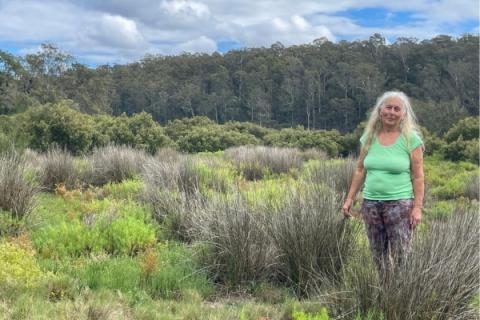Barbara Lindsey and Jon Renn have been at Pub Hill Farm for almost a decade, living their personal conservation values through the preservation of habitat for both threatened species and ecological communities.

Earlier this year they signed an in perpetuity conservation agreement to protect a vital stretch of Coastal Saltmarsh, an endangered ecosystem providing critical support to healthy aquatic life and estuarine water quality of Wagonga Inlet. It also protects over 60 hectares of wet and dry sclerophyll forest, providing habitat for threatened species like the gang-gang and glossy black cockatoo, yellow-bellied glider, and powerful owl.
The conservation area is a major step forward in preserving biodiversity on the NSW South Coast and Barbara said she was excited and proud to contribute to the long-term protection of one of the region’s endangered ecological communities.
“Living here, you come to appreciate how rare and special this landscape is,” Barbara said. “We feel a real responsibility to care for this land, to protect vital habitats and provide sanctuary for both the estuarine and terrestrial wildlife”.
Barbara and Jon have long been dedicated conservationists, previously protecting 52 hectares of coastal heath and forest in Victoria through the Victorian Government’s covenanting body, Trust for Nature.
"We have always felt the importance of conserving the forest,” Barbara said.
“The significance of our property here is primarily to conserve what’s left.”
They have seen first-hand the benefits of active habitat restoration, particularly following the devastating 2019/2020 bushfires that affected most of their property. Their hard work following the fire has resulted in the return of whipbirds, bandicoots, gliders, and a diversity of small birdlife.
Ecologist Jedda Lemmon said the conservation agreement represented a meaningful, permanent addition to the conservation landscape which secures additional protection of saltmarsh habitat adjoining a Marine Park sanctuary zone within Wagonga Inlet.
As threats to coastal habitats grow, Jedda said the agreement marked a proactive step toward ensuring protection of threatened ecological communities in the area.
Coastal Saltmarsh plays a critical role in the health of estuarine ecosystems. Found in the upper tidal zones of estuaries and brackish lagoons, it supports a unique mix of salt-tolerant plants and acts as a natural buffer, improving water quality, providing important nurseries for juvenile fish, storing carbon, and buffering shorelines from erosion.

“This site is a high-quality example of Coastal Saltmarsh on the South Coast, which is under pressure from habitat loss and alteration, rising sea levels and incursion by mangroves,” Jedda said.
“We’re also protecting important populations of sea lavender and shrubby glasswort, both of which are rare in this region.”
Once common in NSW, more than 50 per cent of this habitat has been lost due to land reclamation, drainage, and development and, according to South East Local Land Services, only 30 per cent of the state’s remaining Coastal Saltmarsh is protected, making the private land conservation agreement established at Pub Hill Farm particularly important.
Preserving the land does have its challenges, which Barbara said comes from the wandering stock and dogs of surrounding properties.
“Unfortunately, we have noticed a remarkable drop in the moth population, which we find most distressing, especially as I have been involved in bat rescue for more than 40 years,” Barbara said.
“Microbats and other insectivores rely on a healthy population of moths for their complete diet.
“Despite that, we firmly believe preserving the Australian bush and wildlife is the most important thing one can do in their lifetime.
“The reward of watching happy whipbirds, tiny birds, relaxed kangaroos reclining on our lawn, and lyrebirds in our garden is truly a blessing.”
What is Coastal Saltmarsh?
Coastal Saltmarsh is more than just a beautiful landscape. The South East Local Land Services project, Climate Proofing Coastal Saltmarsh, describes the crucial role it plays in:
- supporting fish nurseries and bird habitat.
- acting as a natural filter, trapping sediments and recycling nutrients.
- providing flood mitigation and shoreline stability.
- sequestering carbon over long timescales due to its waterlogged soils.